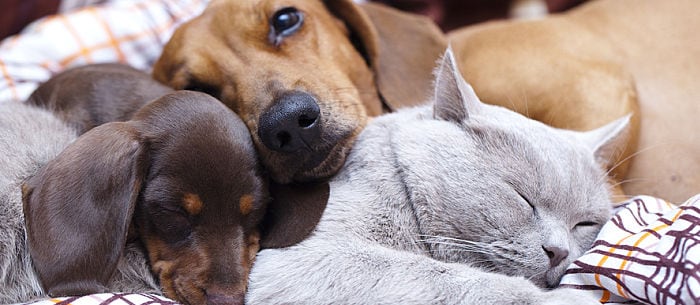What is that big red thing in the corner of your dog’s eye? Or perhaps your cat is looking a little scary with a weird extra “eyeball.” Both dogs and cats are susceptible to “cherry eye” — also known as eyelid protrusion — but there’s plenty you can do to help.
Causes of Eyelid Protrusion
When your dog or cat has an eyelid protrusion, you probably wonder what causes it. The exact cause of eyelid protrusions isn’t known. It’s thought to be genetic or a secondary weakening of the supporting structural ligaments that keep the third eyelid in place. Yes, cats and dogs have three eyelids, consisting of an upper and lower eyelid (like human eyes) and a third inner eyelid.
The glands in the third eyelid are not normally seen, according to Dr. Peter Kintzer, a veterinarian, lecturer, author and expert at Pet Health Network. Cherry eye causes the third eyelid to shift out of place at the lower inside corner of your pet’s eye. It becomes swollen and inflamed and has the appearance of a cherry — thus the name.
Breeds Predisposed to Eyelid Protrusion
According to Dr. Bari Spielman, a veterinarian at BluePearl Veterinary Partners, cherry eye can affect one or both eyes, but it’s less common in cats than dogs. Dr. Kintzer reports that certain flat-faced cat breeds are predisposed to this condition, such as Persians, Himalayans and Burmese cats. Cocker spaniels, bulldogs, bloodhounds, beagles, Lhasa apsos and shih tzus also seem to be more likely than other dog breeds to develop eyelid protrusions.
Eyelid Protrusion Symptoms and Diagnosis
If your pet has an eyelid protrusion, you will see the “cherry” in his eye. Dr. Kintzer explains that the eye may also look red and swollen and may have a pus-like or mucus discharge. Your pet may be pawing at her eye, because it is uncomfortable. Dr. Scott Perry, a veterinarian with Vet24seven, says, “If the gland remains in this position for a prolonged period it may become more inflamed and eventually will appear larger. This effect will make it harder to replace the gland manually in its proper position.”
Your veterinarian will do a complete eye exam on your pet to determine any existing conditions that may be an underlying cause. Her tear production levels may be measured, and an additional test performed to check for an ulcerated cornea.
Get Treatment Early
Schedule an appointment with your vet as soon as you notice the eyelid protrusion. Initial treatment, if you catch it early, could be pretty simple. Dr. Lori Pasternak, a veterinarian with Helping Hands Affordable Veterinary Surgery and Dental Care, says, “Often treatment with anti-inflammatory and antibiotic eye drops will decrease the swelling, and the gland will drop back into the eye socket.”
If your pet’s eyelid is still swollen after your vet treats it with medication, then your pet may need surgery. If the gland remains exposed for too long, explains Dr. Perry, it will eventually start to produce less tears, which can cause the cornea to get dry and inflamed. Also, he adds, “the conjunctiva tissue surrounding the gland is also susceptible to infection as it becomes desiccated, and this will require prolonged use of antibiotics.”
Your vet will likely recommend blood tests before surgery to make certain that your pet can withstand the anesthesia needed to undergo surgery. The affected third eyelid is sutured back into place in the eye. Because the third eyelid is responsible for one-third of your dog or cat’s tear production, it is normally not removed except as a last resort.
If your vet does need to remove it, your pet will require eye drops to moisten his eye for the rest of his life. Your vet will likely put your dog or cat in an Elizabethan collar (or E-collar, or “cone of shame”) to prevent your pet from scratching at his eye while it heals.
Prevention of Cherry Eye
There is no actual prevention method for an eyelid protrusion, though Dr. Pasternak recommends trimming long eye hair to reduce irritation of the eye. Examining your feline or canine friend’s eyes on a daily basis will alert you to the condition early on, so it can be treated quickly. This includes going to a well-lit area and gazing into your pet’s eyes. His eyes should be clear and bright with a white area on the outside. Both pupils should be equal in size, and there should not be discharge, crust or tearing in his eyes. Roll down the bottom eyelid gently to reveal the lower eyelid lining. It should be pink, not white or red. If you’re worried your pet may have the warning signs, make sure you let your pet sitter know so they can keep an eye on your furry friend and can access medical treatment if needed.
For more on pet health, read Dog Eye Infection? The Four Most Common Problems.
Mary Lougee specializes in pet articles with publications in Modern Dog, Pet Planet, eHow Pets, Daily Puppy, Paw Nation-Animals, The Nest Pets and Winged Media. Lougee gained extensive pet knowledge and expertise in care and rehabilitation, built a farm and cares for rescue animals from small to large.
*This article is for general informational purposes only. It is not intended nor implied to be providing medical advice and is not a substitute for such advice. The reader should always consult a health care provider concerning any medical condition or treatment plan. Neither Care.com nor the author assumes any responsibility or liability with respect to use of any information contained herein.



